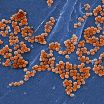INFORMATION:
Additional researchers on this project are Susan Veldheer, research coordinator, Jessica Yingst, research assistant, and Shari Hrabovsky, research nurse practitioner, all at Penn State College of Medicine; Stephen J. Wilson and Travis T. Nichols, both at Penn State; and Thomas T. Eissenberg at Virginia Commonwealth University.
This work was initially funded by an internal grant from Penn State Social Science Research Institute and Cancer Institute, the National Institute on Drug Abuse of the National Institutes of Health and the Center for Tobacco Products of the U.S. Food and Drug Administration.
E-cigarettes less addictive than cigarettes
2014-12-09
(Press-News.org) E-cigarettes appear to be less addictive than cigarettes for former smokers and this could help improve understanding of how various nicotine delivery devices lead to dependence, according to researchers.
"We found that e-cigarettes appear to be less addictive than tobacco cigarettes in a large sample of long-term users," said Jonathan Foulds, professor of public health sciences and psychiatry, Penn State College of Medicine.
The popularity of e-cigarettes, which typically deliver nicotine, propylene glycol, glycerin and flavorings through inhaled vapor, has increased in the past five years. There are currently more than 400 brands of "e-cigs" available. E-cigs contain far fewer cancer-causing and other toxic substances than cigarettes, however their long-term effects on health and nicotine dependence are unknown.
To study e-cigarette dependence, the researchers developed an online survey, including questions designed to assess previous dependence on cigarettes and almost identical questions to assess current dependence on e-cigs. More than 3,500 current users of e-cigs who were ex-cigarette smokers completed the Penn State Cigarette Dependence Index and the Penn State Electronic Cigarette Dependence Index.
Higher nicotine concentration in e-cig liquid, as well as use of advanced second-generation e-cigs, which deliver nicotine more efficiently than earlier "cigalikes," predicted dependence. Consumers who had used e-cigs longer also appeared to be more addicted.
"However, people with all the characteristics of a more dependent e-cig user still had a lower e-cig dependence score than their cigarette dependence score," Foulds said. "We think this is because they're getting less nicotine from the e-cigs than they were getting from cigarettes."
Although many regular users on e-cigarettes are trying to quit smoking, the Food and Drug Administration has not approved them for this use, and they cannot be marketed as a smoking cessation product.
"This is a new class of products that's not yet regulated," Foulds said. "It has the potential to do good and help a lot of people quit, but it also has the potential to do harm. Continuing to smoke and use e-cigarettes may not reduce health risks. Kids who have never smoked might begin nicotine addiction with e-cigs. There's a need for a better understanding of these products.
"We don't have long-term health data of e-cig use yet, but any common sense analysis says that e-cigs are much less toxic. And our paper shows that they appear to be much less addictive, as well. So in both measures they seem to have advantages when you're concerned about health."
The findings, which are published in Nicotine & Tobacco Research, also have implications for developing e-cigs for smoking cessation.
"We might actually need e-cigarettes that are better at delivering nicotine because that's what's more likely to help people quit," Foulds said.
Previous research shows that nicotine replacement efficacy correlates with higher nicotine dose and faster delivery speed.
The new index used in the study is more modern than the most widely used dependence survey, the Fagerstrom Test for Nicotine Dependence. That scale was developed 25 years ago and does not reflect modern use of tobacco and nicotine products.
"People smoke fewer cigarettes today but are still clearly addicted, and the old scale -- while still reasonably effective -- was not designed to measure that," Foulds said.
The new questionnaire also allows for cross-comparisons between different nicotine and tobacco products.
"Not only are e-cigs a booming industry, but new tobacco products are set to enter the market soon," Foulds said. "Our questionnaire is designed to compare dependence across different products simply by substituting the different product name into the questionnaire in place of cigarettes."
ELSE PRESS RELEASES FROM THIS DATE:
Simeprevir-based therapy offers cost-effective alternative in treatment of hepatitis C
2014-12-09
PHILADELPHIA -Researchers at Penn Medicine, in collaboration with a multi-center international team, have shown that a protease inhibitor, simeprevir, a once a day pill, along with interferon and ribavirin has proven as effective in treating chronic Hepatitis C virus infection (HCV) as telaprevir with interferon and ribavirin, the standard of care in developing countries. Further, simeprevir proved to be simpler for patients and had fewer adverse events. The complete study is now available online and is scheduled to publish in January 2015 in The Lancet Infectious Diseases. ...
Light-based technology tracks oxygen levels underwater for swim performance, muscle repair
2014-12-09
BELLINGHAM, Washington, USA, and COLCHESTER, UK -- Swimmers looking to monitor and improve technique and patients striving to heal injured muscles now have a new light-based tool to help reach their goals. A research article by scientists at the University of Essex in Colchester and Artinis Medical Systems published today (5 December) in the Journal of Biomedical Optics (JBO) describes the first measurements of muscle oxygenation underwater and the development of the enabling technology.
The article, "Underwater near-infrared (NIR) spectroscopy measurements of muscle ...
Increased BMI in the normal range has a negative effect on cardiometabolic risk markers
2014-12-09
Increases in excess fat adversely affect multiple cardiometabolic risk markers even in lean young adults according to a new study published this week in PLOS Medicine. The study by Peter Würtz from the University of Oulu, Finland, and colleagues suggests that, even within the range of body-mass index (BMI) considered to be healthy, there is no threshold below which a BMI increase does not adversely affect the metabolic profile of an individual.
Adiposity, or having excess body fat, is a growing global threat to public health. Compared to people with a lean body ...
Genome sequencing traces MRSA spread in high transmission setting
2014-12-09
December 9, 2014 -- Methicillin-resistant Staphylococcus aureus (MRSA) is a common cause of hospital-acquired infections, with the largest burden of infections occurring in under-resourced hospitals. While genome sequencing has previously been applied in well-resourced clinical settings to track the spread of MRSA, transmission dynamics in settings with more limited infection control is unknown. In a study published online today in Genome Research, researchers used genome sequencing to understand the spread of MRSA in a resource-limited hospital with high transmission rates.
Patients ...
Possible genetic link found in treatment-related cognitive issues in children with leukemia
2014-12-09
SAN FRANCISCO (DECEMBER 9, 2014) -Common variations in four genes related to brain inflammation or cells' response to damage from oxidation may contribute to the problems with memory, learning and other cognitive functions seen in children treated for acute lymphoblastic leukemia (ALL), according to a study led by researchers from Boston Children's Hospital, The Children's Hospital at Montefiore, and Dana-Farber/Boston Children's Cancer and Blood Disorders Center.
The data, presented at the 56th annual meeting of the American Society of Hematology (abstract #856), suggest ...
Altered movement of white blood cells may predict sepsis in patients with major burns
2014-12-09
A team of Massachusetts General Hospital (MGH) investigators has identified what may be a biomarker predicting the development of the dangerous systemic infection sepsis in patients with serious burns. In their report in the open-access journal PLOS ONE, the researchers describe finding that the motion through a microfluidic device of the white blood cells called neutrophils is significantly altered two to three days before sepsis develops, a finding that may provide a critically needed method for early diagnosis.
"Neutrophils are the major white blood cell protecting ...
Birdsong study reveals how brain uses timing during motor activity
2014-12-09
Timing is key for brain cells controlling a complex motor activity like the singing of a bird, finds a new study published by PLOS Biology.
"You can learn much more about what a bird is singing by looking at the timing of neurons firing in its brain than by looking at the rate that they fire," says Sam Sober, a biologist at Emory University whose lab led the study. "Just a millisecond difference in the timing of a neuron's activity makes a difference in the sound that comes out of the bird's beak."
The findings are the first to suggest that fine-scale timing of neurons ...
Using genome sequencing to track MRSA in under-resourced hospitals
2014-12-09
Researchers from the University of Cambridge have used genome sequencing to monitor how the spread of methicillin-resistant Staphylococcus aureus (MRSA) occurs in under-resourced hospitals. By pinpointing how and when MRSA was transmitted over a three-month period at a hospital in northeast Thailand, the researchers are hoping their results will support evidence-based policies around infection control.
MRSA is a common cause of hospital-acquired infections, with the largest burden of infections occurring in under-resourced hospitals in the developing world. Whereas genome ...
Nutrient availability can cause whole-genome recoding
2014-12-09
The availability of a trace nutrient can cause genome-wide changes to how organisms encode proteins, report scientists from the University of Chicago in PLoS Biology on Dec. 9. The use of the nutrient - which is produced by bacteria and absorbed in the gut - appears to boost the speed and accuracy of protein production in specific ways.
"This is in some sense a 'you are what you eat' hypothesis,"' said senior study author D. Allan Drummond, PhD, assistant professor of biochemistry and molecular biology at the University of Chicago. "This nutrient that is absorbed through ...
Laughing gas studied as depression treatment
2014-12-09
AUDIO:
Nitrous oxide, often called laughing gas, has been used in medicine and in dentistry for more than 150 years. But researchers at Washington University School of Medicine in St. Louis...
Click here for more information.
Nitrous oxide, or laughing gas, has shown early promise as a potential treatment for severe depression in patients whose symptoms don't respond to standard therapies. The pilot study, at Washington University School of Medicine in St. Louis, is believed to ...



